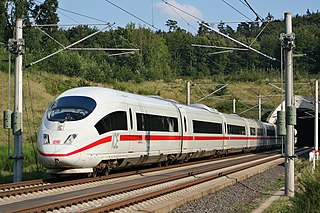
A multiple-unit train or simply multiple unit (MU) is a self-propelled train composed of one or more carriages joined, which when coupled to another multiple unit can be controlled by a single driver, with multiple-unit train control.

Class 316 and Class 457 were TOPS classifications assigned to a single electric multiple unit (EMU) at different stages of its use as a prototype for the Networker series.

The LNWR electric units were ordered by the London and North Western Railway for its suburban services in London. The first cars, made with Siemens equipment, arrived in 1914, and these were followed by two larger batches of units with Oerlikon equipment. The trains were formed into 3-car units, with first and third class accommodation in open saloons. Following the 1923 grouping and absorption of the line into the London, Midland and Scottish Railway (LMS), similar LMS electric units, but with accommodation in compartments, were purchased to run with the Oerlikon units in 1926 and 1932. The trains were all withdrawn by 1960.
The Lancashire and Yorkshire Railway (LYR) built suburban electric stock for lines in Liverpool and Manchester. The line between Liverpool to Southport began using electric multiple units (EMUs) on 22 March 1904, using a third rail 625 V DC. Additional trains were later built for this route, and in 1913 incompatible stock for the route to Ormskirk. Lightweight units were built to run on the Liverpool Overhead Railway.
The London, Midland and Scottish Railway (LMS) introduced a number of railcars to service between 1933 and 1939. Most were single units but one was a three-car articulated set.
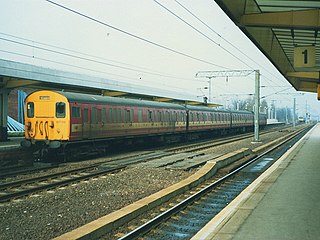
The British Rail Class 307 electric multiple units were built by BR at Eastleigh Works from 1954 to 1956. They were initially classified as AM7 before the introduction of TOPS.

The British RailClass 303 electric multiple units, also known as "Blue Train" units, were introduced in 1960 for the electrification of the North Clyde and the Cathcart Circle lines in Strathclyde. They were initially classified as AM3 units before the introduction of the TOPS classification system, and were the dominant EMU on the Glasgow suburban railway network for over 25 years before being progressively phased out by newer rolling stock. The final units were withdrawn from service in 2002. The fleet's lifespan was 42 years.
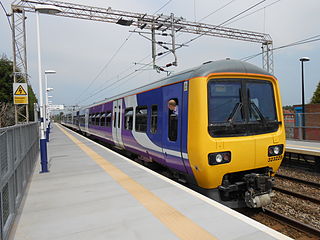
The Styal line is a suburban commuter railway line which runs through south Manchester, England; it commences at Slade Lane Junction, 1.2 miles (1.9 km) south of Manchester Piccadilly, and ends 12 miles (19 km) south at Wilmslow.

An electric multiple unit (EMU) is an electric self-powered train, capable of operating in multiple with other EMUs and without the need for a locomotive; these are typically passenger trains with accommodation in every vehicle and a driving position at each end. The term can also be used to describe a train that is a permanent formation with a non-driving power car, such as the Advanced Passenger Train. As of December 2010, two-thirds of the passenger carriages in Great Britain are formed in EMUs.

The British Rail Class 501 electric multiple units were built in 1955/56 for use on the former LNWR/LMS suburban electric network of the London Midland Region. A total of 57 three-car units were built.

The British Rail Class 306 was a fleet of electric multiple unit (EMU) trains introduced in 1949. It consisted of 92 three-car trains which were used on the Great Eastern Main Line between Shenfield and London Liverpool Street.

British Rail Class 503 passenger trains were 65 mph (105 km/h) electric multiple units. They were introduced in two batches: the first were in 1938, by the London, Midland and Scottish Railway (LMS), with a further batch in 1956 by the then nationalised British Railways (BR). When introduced by the LMS, they were known officially as Class AM3. They were designed for, and operated on, the Wirral & Mersey lines from Liverpool to West Kirby, New Brighton and Rock Ferry. There were few places on their network of closely-spaced stations to attain their maximum speed, except for the open section between Moreton and Meols. All but one set were withdrawn and scrapped by 1985. The final set was used on special Merseyrail services until 1988; it was preserved and kept at the Electric Railway Museum near Coventry, until it moved on to the Locomotive Storage Ltd warehouse at Margate.
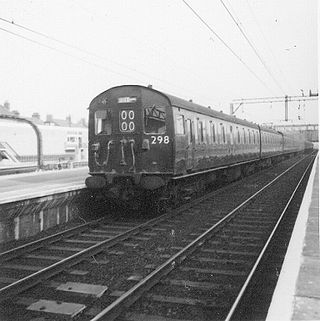
The British Rail Class 302 was a type of electric multiple unit (EMU) introduced between 1958 and 1960 for outer suburban passenger services on the London, Tilbury and Southend line. This class of multiple unit was constructed using the Mark 1 bodyshell and was slam-door.
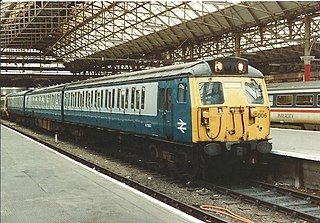
The British Rail Class 304 were AC electric multiple units designed and produced at British Rail's (BR) Wolverton Works.

The British Rail Class 502 was a type of electric multiple-unit passenger train, originally built by the London, Midland and Scottish Railway at its Derby Works. Introduced in 1940 and withdrawn by 1980, they spent the whole of their working lives on the electrified railway lines north of Liverpool.

The British Rail Class 506 was a 3 carriage electric multiple unit (EMU) built for local services between Manchester, Glossop and Hadfield on the Woodhead Line, which was electrified in 1954 on the 1,500 V DC overhead system.
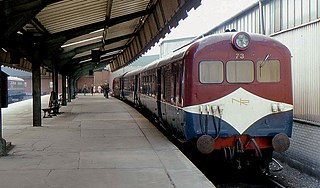
UTA 70 class was a diesel multiple unit train built for service on the Ulster Transport Authority's railway network. The MED’s and MPD’s, which made use of readily available power and transmission units, were cheap to operate but noisier and not as comfortable as locomotive-hauled rolling stock, a fact which made them unsuitable for Inter-City journeys. The decision was made to develop a new generation of multiple unit and in July 1966 the first of the new DEMU sets entered service.

The Manchester South Junction and Altrincham Railway (MSJ&AR) was a suburban railway which operated an 8+1⁄2-mile (14 km) route between Altrincham in Cheshire and Manchester London Road railway station in Manchester.

The Taiwan Railway EMU100 series was a set of rail cars fabricated by British Rail Engineering Limited and the General Electric Company in 1976 that has operated in Taiwan. The alternating current electric multiple unit (EMU) fleet entered full squadron service in 1979, and was withdrawn from service in 2009. This class of railcars were the first to operate on the electric Tzu-Chiang Express. Due to the unit's British origin, rail buffs have variously nicknamed them "British Girl", "British Lady", or "British Grandma".

The ALe 582 is an Italian electric multiple unit train designed for commuter and medium-distance services, developed in the mid-1980s to replace pre-war and immediately post-war EMUs and locomotive-hauled trains on various lines in Sicily and Southern Italy, although they later diffused on the whole FS network. They're part of the "ALe Elettroniche" or "G.A.I." family, together with their predecessors ALe 724 and their successors, the ALe 642.


















